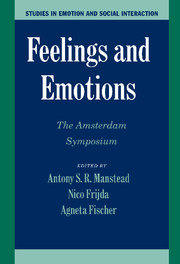Book contents
- Frontmatter
- Contents
- List of Contributors
- 1 Introduction
- PART I THE NATURE OF FEELINGS AND EMOTIONS
- PART II BASIC PSYCHOLOGICAL PROCESSES IN FEELINGS AND EMOTIONS
- PART III FEELINGS AND EMOTIONS: THE PLACE OF PLEASURE
- PART IV FEELINGS AND EMOTIONS IN THEIR SOCIOCULTURAL CONTEXT
- 18 The Development of Individual Differences in Understanding Emotion and Mind
- 19 Emotional Intelligence
- 20 Culture and Emotion
- 21 Emotion Norms, Emotion Work, and Social Order
- PART V FEELINGS, EMOTIONS, AND MORALITY
- Subject Index
- Author Index
- Plate section
- References
18 - The Development of Individual Differences in Understanding Emotion and Mind
Antecedents and Sequelae
Published online by Cambridge University Press: 05 June 2012
- Frontmatter
- Contents
- List of Contributors
- 1 Introduction
- PART I THE NATURE OF FEELINGS AND EMOTIONS
- PART II BASIC PSYCHOLOGICAL PROCESSES IN FEELINGS AND EMOTIONS
- PART III FEELINGS AND EMOTIONS: THE PLACE OF PLEASURE
- PART IV FEELINGS AND EMOTIONS IN THEIR SOCIOCULTURAL CONTEXT
- 18 The Development of Individual Differences in Understanding Emotion and Mind
- 19 Emotional Intelligence
- 20 Culture and Emotion
- 21 Emotion Norms, Emotion Work, and Social Order
- PART V FEELINGS, EMOTIONS, AND MORALITY
- Subject Index
- Author Index
- Plate section
- References
Summary
ABSTRACT
The chapter examines the relations between children's understanding of others' inner states and their socioemotional experiences and relationships, both concurrently and over time, and the place of talk in these developments. It is framed within a relationship perspective, draws on evidence from longitudinal studies of children, and discusses what we need to know now.
INTRODUCTION
No one who has been around young children can fail to have noticed the emotional drama of their lives – the intensity and frequency of their displays of anger, delight, distress, and humor. If you listen to what they are saying – their questions, jokes, stories, and arguments – their interest in and curiosity about emotions are also strikingly evident. There has of course been a long tradition, since Darwin, of research that charts the developmental changes in children's emotional behavior, and the organization of emotions, a tradition that continues today. There is also flourishing research on the regulation of emotional behavior and its relation to developmental psychopathology, and to close relationships more generally (Eisenberg, 2000; Eisenberg et al., 1995). This chapter however focuses not on these active areas of study, but on another theme that is increasingly prominent in developmental work on emotions. This is the significance, antecedents, and sequelae of individual differences in children's early understanding of emotions. As adults, our understanding of other people's feelings plays a crucial role in our relationships, in our interpretation of people's actions and intentions.
- Type
- Chapter
- Information
- Feelings and EmotionsThe Amsterdam Symposium, pp. 303 - 320Publisher: Cambridge University PressPrint publication year: 2004
References
- 5
- Cited by

